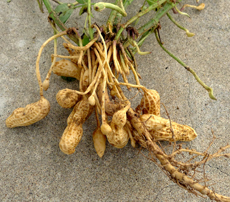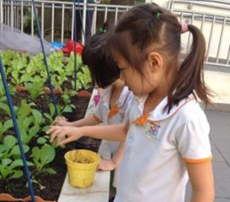It's Fun Growing Your Own Peanuts!
Growing peanuts is a fun activity for the family.
The peanut plant is one of the most intriguing plants in the plant kingdom. As a child, I was curious to know why the fruits of the peanut plant were also called ground nuts. The answer I was given was that they are harvested by digging the plant out from the ground, which is unlike how we usually harvest fruits – by plucking them off branches.
I also wanted to know how the fruits of the peanut plant were produced and how they ended up underground, so I asked my Mother to bring me to the provision shop to buy some raw peanut seeds which I then sowed into a pot of soil. That kick-started my journey of discovery.
This is how the peanut plant looks. Its fruits are all produced below the ground.
After harvesting the peanut fruits from the plant, check if the leaves are still healthy, that is, without brown spots on them. Leaves and stems from healthy plants can be turned into compost, which is a valuable source of organic matter for the garden.
To this day, I find the peanut plant and its seeds powerful tools for sharing valuable lessons with the younger generation. For instance, how plants grow and how food is produced – such processes can be hard to witness in highly-urbanised Singapore.
Getting Started…
Before you start growing the peanut, make sure no one at home is allergic to nuts and their products!
To start growing the peanut plant, you can buy raw peanuts with their shells still intact or shelled raw peanuts from the supermarket. I prefer the former as the seeds are fresher and germination is more likely to be successful as compared to the dried ones.
For container-growing, you can use a regular potting mix from the local nursery that is well-draining. A flower pot with a diameter of at least 20cm is sufficient for growing a peanut plant. If you intend to grow the plant outdoors, avoid a site with heavy clay soil as it will impede proper fruit development. Peanut plants are sun-lovers so you should place the pot in a sunny location where it can be exposed to at least six hours of direct sunlight.
To start, sow two to three seeds either directly into the pot or into the ground. Make a hole with your finger to a depth of about 2cm and lay a seed horizontally at the base of the hole. Once that is done, cover the seed with some potting mix or soil. After all the seeds have been sown, water the potting mix thoroughly. Water at least once daily to keep the soil moist. Seeds will start to germinate in a few days and seedlings will usually appear in about a week.
Watching them grow…
Under optimal conditions, peanut seedlings grow relatively quickly and flowering usually occurs in about a month after germination. You will see the dainty little yellow-orange flowers amid the lush green foliage. After each flower has been pollinated, the petals will fall off to reveal a peg (a peg is a budding ovary which grows out into a stem) which grows a long stalk that will find its way downwards to the soil surface. It will then bury itself in the loose soil beneath the ground and begin the development process to become the peanut that we are all familiar with.
This is how a peanut plant looks. Depending on the variety, some can grow as tidy, rounded mounds whereas others adopt a trailing growth habit.
During the growth period, ensure plants are well watered as they should never be allowed to dry out totally. Plants should preferably be fed regularly with a complete fertiliser that can either come in the water-soluble or slow-release pellet form.
It is important to grow peanuts during the drier period of the year. The plants will be prone to diseases if grown during the tropical rainy season.
Harvesting & enjoying them…
Peanuts are ready for harvest about three months after planting. This may vary according the variety grown, so some take require more time before harvesting. One way to find out if they are ready is to scratch the soil a little to look at the size of the fruits or to glimpse at the number of pegs buried in the ground.
To harvest them, you should carefully dig the plants out from the ground using a hand hoe. After that, the individual peanut fruits can be plucked from the plant and washed.
Freshly harvested peanuts can be enjoyed simply by boiling them in water with a little salt added. Get your kids involved in the harvesting process and let them discover how the peanut fruits are produced. Also have them wash and prepare the fruits for cooking. It will be a little dirty but definitely fun experience!
Look at the root zone of the peanut plant carefully. Besides the fruits, another interesting structure to look out for are the small round spheres that grow on the roots – these are root nodules that contain useful bacteria that harness nitrogen gas from the atmosphere and turn it into a form of nitrogen that plants can absorb for growth.
Did you know?
Peanut plants belong to the bean family (Fabaceae). Like the Rain Tree that grows along our streets, peanut plants also respond to darkness by closing its leaflets. For the excited and curious kid, you can put your potted peanut plant inside a cupboard for a while to watch this happen, or get them to watch the plant 'sleep' near bedtime when the skies have darkened.
By Dr Wilson Wong
Captions:
You can grow several peanut plants closely to form an attractive 'living' mulch which can help to protect the soil surface from erosion and compaction due to heavy rain.
Peanut plants produce dainty yellow flowers which last only a day. The best time to admire them is when they first open in the morning, before they wilt!











Have views or comments on this article? Let us know via this form. If you would like to give us feedback on any other areas relating to our parks and gardens, please submit via https://www.nparks.gov.sg/feedback